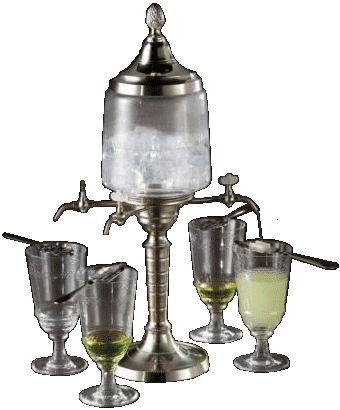
SethP on Absinthe
(La Fée Verte)
The following pages will be about absinthe. Absinthe (with -he at the end) is basically the French and English name, and since absinthe originates from the borderlands between Switzerland and France, it has in practice become the internationally recognized name. The distinction is due to the unfortunate fact that there are some variants and counterfeit products on the market often labeled absinth (without the -e). However, I would really prefer not to call those absinthe at all, since at their core they are something entirely different.
But what is (real) absinthe, actually? Well, of course, this is the question that must be answered first and foremost. If you just want the quick, basic, and easily digestible answer, you can skip ahead to a nine-minute film (with Swedish subtitles and that I've have translated) which can be found on the Facts page.
Otherwise, in short, it is an alcoholic beverage, and as such it obviously does not go together with, for example, driving, operating machinery, or if one has problems with alcohol in general. Absinthe is most often green, which I will cover in the Facts section, but there are also completely colorless varieties and some that are red. Furthermore, it is an anise-flavored drink, somewhat like pastis, ouzo, or raki, but unlike these, wormwood is the absolutely most important and defining ingredient in absinthe. Without wormwood—no absinthe, quite simply. But not just any wormwood (as a base) will do. For it to be real or genuine absinthe, it must contain the variety commonly called grand wormwood (with the Latin name Artemisia absinthium), as opposed to, for example, Roman wormwood. It is moreover from the Latin name absinthium that the drink got its name. Roman wormwood, and perhaps also other species, can also be used in absinthe (of course), but absinthe must, as said, contain Artemisia absinthium.
Some people believe that wormwood- and anise-flavored liquor is enough for it to count as absinthe, but this is just simply wrong. Genuine absinthe is always a distillate of at least three different herbs (wormwood, anise, and fennel), that is distillation after the herbs have been macerated in strong alcohol. This means, quite simply, that it is hardly feasible to try making real absinthe at home, since it must be distilled. Home distillation (that is, the distillation of alcohol) is, as you surely know, prohibited in most countries, and Sweden is definitely no exception.
What else needs to be said about absinthe at this introductory stage? Well, that we are talking about strong spirits. Absinthe generally ranges between 55 and 72% alcohol by volume (110 to 144 proof). But… it is absolutely not a drink to be consumed neat, like a shot for example. No. Nope! Not at all. Traditionally, absinthe is always drunk with shilled or ice-cold water, but the drink is also included in many cocktail recipes.
So.. Welcome to explore my following pages about absinthe. Next, we will turn to the drink’s fascinating history.
